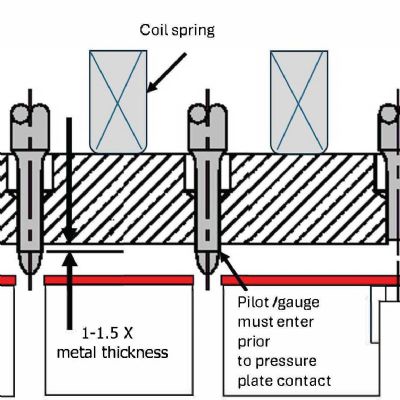The solution: flush-mounted nuts installed via the Pemserter in-die system in a 600-ton progressive-die operation. The cold-rolled steel accepting this nut insertion is 1.5-mm thick.
“For this light material, PennEngineering provided a robust fastener design that achieves the push-out and torque requirements for our part,” says Carlton. “The Pemserter system feeds three M8 nuts at a time in different stations of the tool with each press stroke, from the bottom up. This is not a conventional direction of feed in most applications. Fortunately for us, Penn-Engineering had a bottom-feed process that accommodated our engineering change after the tool was built.”
 |
| Depicted at left is the original part design with a protruding nut. At right is the redesigned part that takes advantage of a new in-die-fastening system and flush-mount fasteners. Flush mounting allows for a simplified part without extra forming and embossing needed to place a nonflush-mount nut |
Simple to Set Up and Operate
Commenting on the feed equipment, Carlton noted that PWO Canada toolmakers and maintenance staff were pleasantly surprised at the ease of setup. That’s assisted by the use of multi-pin twist-lock connectors that makes the Pemserter in-die system virtually plug-and-play, according to PennEngineering officials. All that’s needed to operate the system: a standard 110-V receptacle and shop air. On top of that, the system stays online, according to Carlton, with minimal service required.“This equipment has run virtually maintenance-free through insertion of more than 1 million fasteners without incident,” he says, adding that personnel also were impressed with the compact size of the feed apparatus as well as the ease of integration with the tooling and the feed system. “And the ability to outperform our press speeds went well beyond that of competing systems.”
The insertion process offered by the system allows nut feed from either the top or bottom, which Carlton says assisted in tool design, with quality assured via the built-in nut-detection and sensoring system that provides direct feedback to the press control. To run the process, an operator is guided by a touchscreen interface and online library of fault/help screens.
Along with the technical prowess of PWO Canada’s new in-die-fastening process, Carlton cites engineering and technical support as well as a concise training program from PennEngineering that allowed a successful launch at his facility.
“No tweaking, no retrofitting, no major adjustments,” he says. “We just hit the ground running.” MF
View Glossary of Metalforming Terms
See also: PennEngineering
Technologies: Tooling
Comments
Must be logged in to post a comment. Sign in or Create an Account
There are no comments posted. Stamping Presses
Stamping PressesIncreasing Press Speed and (In)Efficiency
Peter Ulintz Thursday, March 30, 2023







